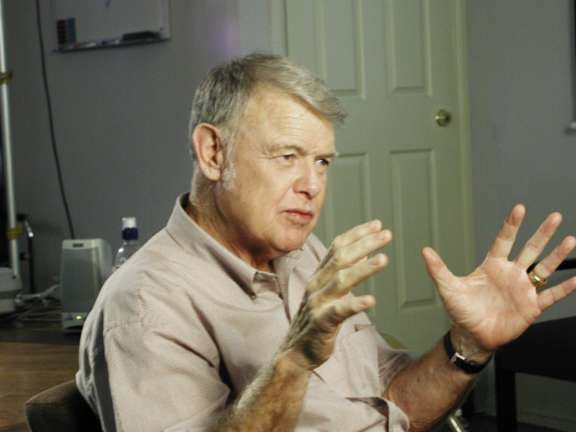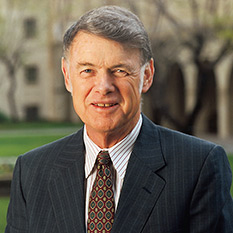Louis D. Friedman • Aug 29, 2013
Bruce Murray (1931-2013)
One of the most remarkable minds of 20th century exploration was stilled this morning, August 29, 2013, when Bruce C. Murray died of Alzheimer’s disease at the age of 81. The Planetary Society owes its existence to Bruce, who with Carl Sagan, decided in 1979 that the world needed an organization that would harness the public’s fascination for planetary exploration and demonstrate to politicians that voters would support those who supported planetary exploration. Bruce and Carl directed the organization together for sixteen years, until Carl’s death, and Bruce took over as president for another 5 years.
The world knew Bruce Murray as Director of the Jet Propulsion Laboratory in Pasadena, from the triumphant Viking landings on Mars, through Voyager’s encounters at Jupiter and Saturn, to the start of Galileo to Jupiter and Magellan to Venus. Discover magazine dubbed him “the Admiral of the Solar System,” a title for which he took a lot of teasing from those who knew and loved him. Bruce’s great hero was Captain James Cook, the great explorer of the seas, and he may have been secretly pleased to have been given a title – even if entirely unofficial -- that recalled great explorers of the past.
As a young man, Bruce did not set out to become a planetary explorer. He went through MIT through the ROTC program, and after getting his PhD in geology, he served two years with the US Air Force. He then spent several years prospecting for petroleum for Standard Oil. He found his way to Caltech where, in the early 1960s, geologists were beginning to look at Earth’s neighboring ball of rock, sometimes called the Moon, as an object worthy of study.
Bruce became a pioneer in planetary imaging and earned an appointment as a professor of Geological and Planetary Sciences at the California Institute of Technology. He began his Caltech career by using big telescopes, such as the 200-inch Hale telescope on Palomar Mountain, to observe the Moon and Mars through the infrared to try to figure out what substances lay on their surfaces. As the Space Age progressed and people started launching spacecraft to get close to the planets under study, Bruce was appointed to the Imaging Team for the first Mariner missions to Mars. His skills in imaging, wrangling fellow scientists, and communicating with the public led to his appointment as Imaging Team Leader for the Mariner 10 mission to Mercury. Not long after that success, he was appointed Director of the Jet Propulsion Laboratory.
Bruce profoundly influenced the course of planetary exploration from the very beginnings of the space age. On a personal note, he profoundly influenced us as our leader at The Planetary Society, as a family friend, and for one of us (LDF) as a mentor and boss at JPL before The Planetary Society. (I was assigned to go meet Bruce Murray on my first day of employment at JPL, to work on the Mariner-Venus-Mercury (Mariner 10) mission where Bruce was the lead imaging scientist --- LDF).
It is through its spectacular images of other worlds that the space program has captured the hearts and imaginations of members of the public. Few know that, without Bruce, there might not be so many wondrous images to entrance us. In the early days of planetary exploration, the idea of taking along a camera to snap pictures of the planets was controversial. The space science community was dominated by physicists who thought taking pictures was a public relations stunt that would eat up data, spacecraft power and mass resources that should be reserved for other instruments that they found more scientifically valuable. Working with his colleagues at Caltech, notably Robert Leighton and Robert Sharp (for whom Mt. Sharp is named on Mars), Bruce changed that. He literally helped change our picture of the solar system.
The planet Earth, especially the dry desert areas that entrance many a geologist, was also a target for Bruce’s scientific ponderings, even while he led the charge to Mercury, Venus, Mars, and beyond. Through his work on so many worlds, Bruce helped invent the field of comparative planetology. Those scientists who today study planetary processes such as seismic events, climate change, the history of water, cratering, and so on by comparing them among different worlds are following in Bruce’s footsteps
A Tribute to Bruce Murray (1931-2013)
Personal stories of Planetary Society Members
A key to Bruce’s success was his willingness to reach out to others who might have something to teach. When he and Carl saw the need for an organization that would promote and defend planetary exploration, they did not have a clear idea of how such an organization should work. Bruce enlisted the aid of John Gardner, who had served as Secretary of Health, Education, and Welfare under President Lyndon Johnson and received the Presidential Medal of Freedom in 1964, before going on to found Common Cause and become an expert at building of public constituencies. Gardner became Bruce’s mentor and taught him the steps to building an organization like The Planetary Society.
For example, Bruce initially thought that a simple mimeographed newsletter would be sufficient means to communicate with Planetary Society members. But those who, like John Gardner, Bruce enlisted to help form the organization (as well as Carl, of course) emphasized that the gorgeous color pictures of the planets were our best and most inspiring means of communicating the value and inspiration of space science. Thus, was born The Planetary Report.
While Bruce had a reputation for suffering fools badly – a trait his mother frequently lectured him about – he was remarkably willing to change his mind and admit when he was wrong. He acknowledged the expertise of others and attracted brilliant people to his projects. At The Planetary Society we saw this when he was willing to dismiss his reservations about the use of direct mail to build our large membership base. In his scientific work, he was willing to overcome his skepticism about the accessibility of water on Mars. His rigorous insistence on intellectual honesty often made him controversial, especially when dealing with the often contentious politics of the space program. But those same qualities made him widely admired and sought after for advice on the direction the space program should take into the future.
Bruce was honored by the Society twice with formal dinners, once in 1990 on the occasion of the Society's 10th anniversary, and again in 2002 when he formally retired from Caltech and stepped down as President of The Planetary Society.
Bruce also gave direction to Planetary Society programs. He initiated our deep involvement in the development of a Mars balloon, first with students in a summer program at Caltech, next with research and development funded by members of The Planetary Society, and then in close collaboration with French and Russian scientists. Unfortunately, the collapse of the Soviet Union meant that a Mars balloon never flew — or one has not flown yet. The concept lives on.
Together with Carl, Bruce also pushed the Society into the Search for Extraterrestrial Intelligence (SETI) when U.S. government support for it at NASA was curtailed. This led to our multiple SETI projects that began with Suitcase SETI in 1982 and continue today. Bruce and Carl also encouraged the Society to support the search for exoplanets at a time when it was relegated to borrowed time on a few small telescopes at minor observatories. SETI has yet to make a discovery of extraterrestrial intelligence, but scientists following Bruce and Carl’s lead have certainly vindicated their prescience by finding exoplanets nearly everywhere they look.
With his wife Suzanne, Bruce traveled extensively, not just as tourists but in connection with in-depth involvement in science programs. He was a visiting Professor at the University of Paris, a Visiting Associate at Tsinghua University in Beijing, and a Visiting Professor in Japan at the Institute for Space and Astronautical Sciences. Bruce served as an interdisciplinary scientist on several Russian Mars missions and participated on the Soviet-French Venus-Halley mission. He served as Director of Kerr-McGee Corporation, as a member of the NASA Advisory Council, Chair of the COMSAT Technical Advisory Council, a member of the ARCO Scientific Advisory Council and of the Scientific Advisory Committee of the Defense Intelligence Agency.
Bruce’s most visible legacy may lie with the institutions with which he was principally associated: Caltech, JPL, and The Planetary Society, but his biggest legacy is the outstanding group of planetary scientists who were once his students. So many of the great discoveries of the last few decades of planetary science have been made by those who were trained in their work by this demanding, gruff, brilliant, and deeply caring man. Every human and every robot now exploring the planets owes a debt to Bruce Murray. We were enriched by having known the man; the world of science and exploration is so much poorer for his loss.
Support our core enterprises
Your support powers our mission to explore worlds, find life, and defend Earth. You make all the difference when you make a gift. Give today!
Donate

 Explore Worlds
Explore Worlds Find Life
Find Life Defend Earth
Defend Earth



